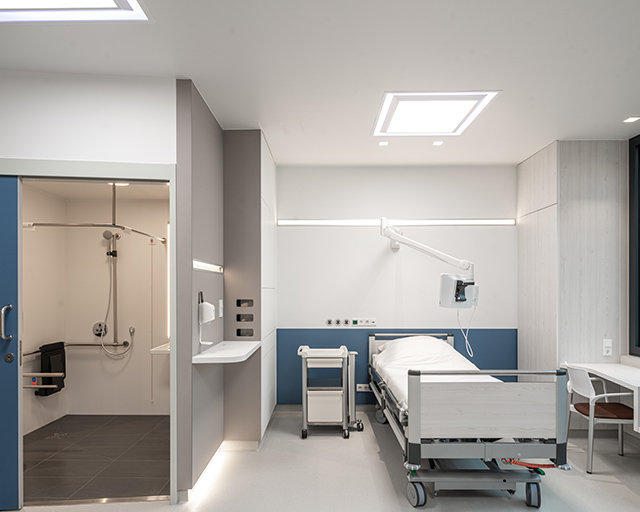Better hygiene thanks to easy-to-clean materials
Together with the experts from the hospital, the scientists from TU Braunschweig and Fraunhofer now want to develop further practical model solutions for hospital architecture. These include materials, surfaces and equipment elements that are easy to clean and thus help to contain dangerous germs. In this context, sensors and new innovative cleaning systems that quickly identify and automatically remove germ contamination will also be tested.
In the research and study laboratory, the researchers want to test the extent to which new products and functional materials are suitable for use in a hospital room and make them tangible for different user groups – for example from treatment, care, cleaning and supply and disposal. Which disinfection dispensers are suitable and where they should best be placed in the room are examples of questions that need to be answered. Another central aspect concerns the lighting in the room: where should the light be installed, how can it be controlled and operated? Solutions will also be offered for this. The investigations in the demonstrator will be accompanied by the construction of a cyber system that, in addition to monitoring energy and material flows for economic analyses, can also be equipped with elements that monitor the patient's vital parameters to ensure optimised patient care.
The cooperation is planned for at least five years and will take into account the constant change in the care sector. New developments in medicine, changes in societal demands as well as advances in architecture, construction and material sciences will be incorporated into the work.
Involvement of industrial partners
The cooperation partners want to set up the model patient room in September 2021 on the grounds of the Braunschweig Municipal Hospital in Naumburgstraße. This is primarily intended to provide medical staff with access for practical examinations.
As already in the design phase of the KARMIN demonstrator, the research team wants to involve industrial partners. “The field of care and in particular the patient room in hospitals will have to react to further changes in the future, such as new diseases or even decreasing numbers of beds in hospitals,“ says Dr. Wolfgang Sunder from the Institute of Construction Design, Industrial and Health Care Building (IKE) at TU Braunschweig. “The knowledge gained from the cooperation should flow as directly as possible into the planning and construction processes of healthcare buildings, be transferred into the professional practice of clinics as well as into the development of corresponding products.“
“Functionalised surfaces and automated cleaning systems have the potential to become game changers in the hospital of the future. The patient room offers an ideal development and test environment for the development of new product systems and functional materials,“ adds Prof. Dr. Christoph Herrmann, Director of the Fraunhofer Institute for Surface Engineering and Thin Films IST. “In addition to the aspects of health protection, the sustainable production and implementation of our ideas with industrial partners is also the focus of our work.“
“Other aspects that will be pursued with the patient room of the future are to optimise the quality of treatment during the hospital stay as well as the work of the medical and nursing staff,“ says Dr. Thomas Bartkiewicz, Medical Director of the hospital. For example, it is possible to practise various case constellations in the patient's room using augmented reality. “This is a great benefit in the training and further education of future doctors and nursing staff,“ Bartkiewicz is pleased to say.
Cooperation partners
The research team combines the disciplines of building design and material, layer and surface technology, represented by the Institute of Construction Design, Industrial and Health Care Building (IKE) of the TU Braunschweig and the Fraunhofer Institute for Surface Engineering and Thin Films IST. Both institutes have many years of research experience in the health sector.
In addition, both institutions have been cooperating in teaching and research with the Braunschweig Municipal Hospital for more than ten years. As a maximum care hospital, the clinic provides university-level care to the region of Braunschweig. In 2013, the joint development of plasma-coated bags for stem cell cultivation by the Fraunhofer IST with the Municipal Hospital was awarded the Fraunhofer Prize “Technology for People“.
KARMIN research project
KARMIN stands for “Hospital, Architecture, Microbiome and Infection“. The project was funded by the Federal Ministry of Education and Research (BMBF) from October 2016 until the end of 2020 within the framework of the funding measure “Zwanzig20“ and as part of the research network “InfectControl 2020“. In addition to the TU Braunschweig, the collaborative partners were the Institute for Hygiene and Environmental Medicine of the Charité – Universitätsmedizin Berlin, the University Hospital Jena with the Septomics Research Group and Röhl GmbH. The research team investigated how new room planning can reduce the transmission of pathogens and developed a design for an optimal infection-proof patient room including a wet room. The prototype of the patient room was presented to an international audience of experts at the Berlin "World Health Summit" in October 2020.


